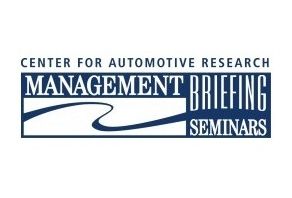CENTER FOR AUTOMOTIVE RESEARCH MANAGEMENT BRIEFING SEMINARS – DAY TWO
 |
By Steve Purdy
The Auto Channel
Michigan Bureau
 |
We’ve been sorely disappointed in the weather along Michigan’s Gold Coast. It is intensely hot with little breeze off the big lake. We’re not, however, disappointed in the vibrancy we find at the conference. All the usual suspects are here - tier one and tier two suppliers, the OEMs, analysts, strategists, government officials and swarms of executives of many stripes. Among them we’re noticing a lot of fresh blood. That means, we contend, the auto business is healthy and optimistic.
A big topic of conversation continues to be around autonomous and self-driving vehicles, some of which we reported on yesterday with the Continental Automotive- and Magna-supported drive from Detroit to Canada to Traverse City making for the first international drive of automated cars. While most experts think level 4 and level 5 autonomy are still a long way some expect the first applications will be fleet and commercial users rather than consumers.
We’re also hearing from Bosch with concerns about whether consumers will ever accept giving up control of their vehicles and how limited their knowledge is about other safety systems like stability control that have been around for a while. Bosch, said the company’s VP of automated driving, is addressing these issues as well as being immersed in the further development of the technology. A system Bosch is working on now is focused on allowing the car to safely pull over and stop with no driver input in a situation where the driver does not, or can not, take control when needed.
Let’s talk about contract engineering. OEMs and suppliers often need more engineering expertise than they can generate in-house. One problem, as alluded to earlier in these narratives, is the shortage of qualified engineers and another is the cyclical need for intensive engineering as projects wax and wane. One of these contract engineering companies is AM General, perhaps best known for designing and manufacturing military trucks, think of the Humvee and Deuce-and-a-Half truck. AM General executive VP Kevin Rahrig suggested that a start-up company intent on building the next futuristic vehicle, for example, can hire them to do both the engineering and manufacturing. They do both.
Along the lines of non-OEMs making whole cars or major components we learned this week Mercury Marine is thinking about making high-performance car engines as their boat business wanes. That company made engines for the Corvette ZR1 in the early 1990s. That motor was way more sophisticated than GM wanted to do themselves. As the ZR1 aged, though, it became nearly impossible to find and afford parts when something went wrong or wore out. Powertrains today, even the low end ones, are more sophisticated, and much better designed and built than in the 1990s. So, we’re wondering if they have some wonderful new engine innovations up their sleeves.
Do you suppose everything has to become electrified? Craig Balis, Honeywell CTO, talked about that supplier’s efforts to develop an electric turbocharger for mainstream vehicles. Currently they are used in racing applications so they may be closer than we think. Honeywell believes this technology could soon be common as automakers try to squeeze every last erg of energy out of a drop of fuel. The electrified turbo, we learned from Honeywell North American boss, Milind Godbole, will be most relevant as cars move to a 48-volt electrical system as it will be able to feed electrons back into the batteries under certain circumstances rather than loosing energy out a waste gate as do traditional turbos. And, the electric turbo will not generate the kind of ungodly heat that wastes energy and must be expensively dealt with.
Industry leaders from Toyota, Mazda, Magna and others offered more powertrain insights as they look into the future planning for the long term. We auto enthusiasts are gratified to hear continuing support for the ICE (internal combustion engine) we all love. While they seem to agree that electrification of powertrains will continue they also agree that ICE will be in the mix, though sometimes hybridized in various levels. In spite of intense efforts to develop full electric vehicles no one seems to expect those to be a significant piece of the market for many years to come.
We love the conference in Traverse City not only for its distillation of industry issues and the accessibility of top executives but for the social events as well. Our Tuesday evening began with the usual hospitality under a huge tent on the resort’s back patio where the din of conversation and networking grows to a high-energy roar then slowly dissipates. We then drove over to the West Traverse Bay where we boarded an old two-masted schooner for a lovely sunset cruise dinner at the invitation of the Millerschin Group, a PR agency representing a variety of suppliers. We ended the evening at the Hagerty Garage full of classic and collector cars and equipment for their restoration at the behest of the Traverse City Economic Development Office. Hagerty Insurance is the largest private employer in TC and by far the major purveyor of classic and collector car and boat insurance in the U.S.
Stay tuned for more reports from the Center for Automotive Research’s annual Management Briefing Seminars.
© Steve Purdy, Shunpiker Productions, All Rights Reserved


